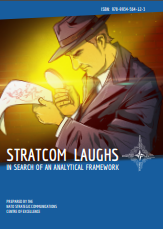USE OF HUMOUR FOR SOLIDARITY, DENIGRATION AND STRESS-RELIEF IN THE UKRAINIAN MEDIA DURING THE RUSSIAN AGGRESSION IN 2014-2016
USE OF HUMOUR FOR SOLIDARITY, DENIGRATION AND STRESS-RELIEF IN THE UKRAINIAN MEDIA DURING THE RUSSIAN AGGRESSION IN 2014-2016
Author(s): Maksym Kyiak
Subject(s): Psychology, Media studies, Geography, Regional studies, Communication studies, Social psychology and group interaction, Methodology and research technology, Evaluation research, Present Times (2010 - today)
Published by: NATO Strategic Communications Centre of Excellence
Keywords: Russia; Ukraine; Crimea; aggression; communication; strategic communication; humour; media; psychology; stress-relief;
Summary/Abstract: Ukraine is a unique case for study as far as the use of humour as a strategic communication tool is concerned. Russia launched a massive information war against another country. During the first months after the annexation of Crimea and the war in Eastern Ukraine, there was no unified or coordinated approach to countering Russian propaganda. Furthermore, during the first phases of the war, civil and military volunteers, and the Ukrainian diaspora took the place of the official Ukrainian authorities in countering Russia’s information attacks. A horizontally organized, post-Euromaidan Ukrainian civil society had to combat Russia’s vertically constructed propaganda machine. That horizontally structured civil society provided such functions of humour as solidarity (belongingness) and stress-relief. As the information war progressed, Ukraine, a country with no real experience in counterpropaganda and with restricted financial capacity, had to learn how to fight back, literally from square one. That is why Ukraine counterpropaganda and use of humour were and still are more a product of a variety of independent and spontaneous initiatives, rather than a systemic approach. Nevertheless, the diverse landscape of humour in the Ukrainian media provides a rich source of information for the case study.
Book: STRATCOM LAUGHS - IN SEARCH OF AN ANALYTICAL FRAMEWORK
- Page Range: 122-139
- Page Count: 18
- Publication Year: 2017
- Language: English
- Content File-PDF

